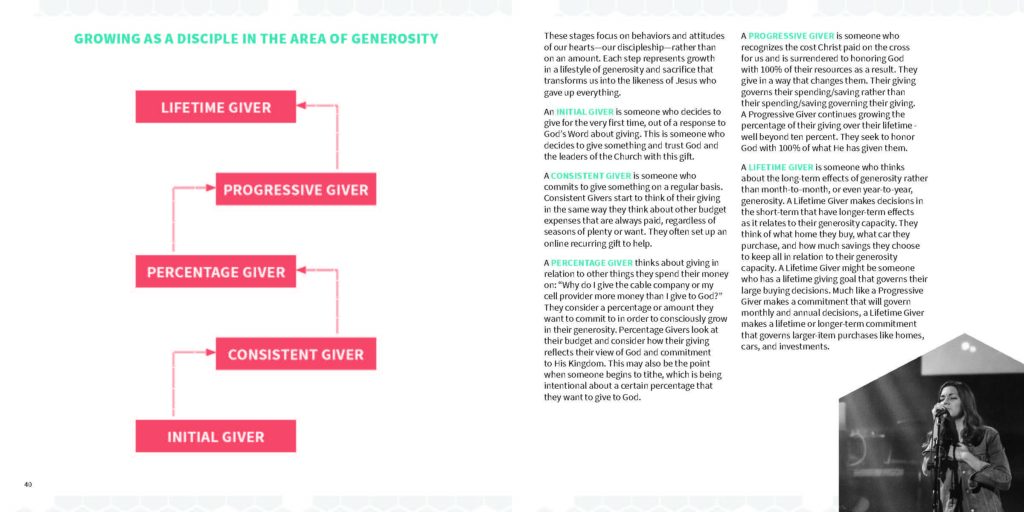The Next Steps of Generosity
GenerosityIn a recent debrief with the senior pastor and generosity team of a current church client, we spent time reviewing the just concluded public phase of their recent initiative. (I always value this conversation with my clients – What did we learn? What worked? What didn’t? What should we change next time? It’s most helpful to get that information while it’s still fresh in everyone’s mind.)
The most significant takeaway for the pastor in this instance was a tool we implemented together to help establish some “generosity next steps” language the church can continue using from this point forward.
I’ve written about the concept before. We’ve discussed creating on ramps to the giving path, the discipleship path of generosity, and even a prayer journey of generosity. It’s a good idea to check back on these posts to regain a big picture perspective when you review your church’s process.
NEXT STEPS PROCESS…
This particular church has an extremely clear (and very effective) next steps philosophy for the assimilation of new people. They are brilliant at this implementation (as is reflected by their appearance on Outreach Magazine’s Fastest-Growing Churches list).
If you’re a first time guest at this church, you know your next step is an evening with the pastor called Open Mike Night. (Yes, the pastor’s name is Mike. Clever isn’t it? Not sure what they’d call it if his name was Ralph. 🙂 )
After attending Open Mike Night, those new to the church are encouraged to sign up for a four-week Connect group. There, they are paired with a Connect Coach, and each step following is meticulously thought through and effectively employed.
BACK TO GIVING…
So how is this next steps process related to generosity, you ask? This church didn’t have this in place before we teamed up, but quickly realized the value of such a strategy.
If someone needs to know the next steps to becoming involved in the church, wouldn’t they also need to understand the next steps of generosity? (And as it turns out, people who had been involved there for several years had some of these same questions too!)
- If I’m new to this giving thing, what’s my first step? How do I start?
- If I’ve been giving for a long time, what would be my next step?
- If I’m one who tithes, is there another step for me, or am I good?
WHY IMPLEMENT A GENEROSITY NEXT STEPS PROCESS?
Simply, it’s all about meeting people where they are and encouraging them on the journey. It’s all about meeting people where they are and encouraging them on the giving journey. Click To Tweet
Giving 10% sounds nearly impossible to someone who is not giving at all. And someone already giving 10% may not realize they still have steps to take. But a well devised next steps plan of generosity helps people know both where they stand on the path, as well as their next step to take.
When creating this process for your church, you can decide how many steps are on the path, and how best to label and define each step. I would recommend no fewer than three, and no more than five.
Your steps might include:
- An Initial Giver is someone who decides to give for the first time; someone who decides to give something and trust God and the leaders of the Church with this gift.
- A Consistent Giver is someone who decides to give something and to give it on a consistent basis, often making his or her gift an online recurring gift.
- An Intentional Giver is someone who is beginning to think about their giving in relation to other things they spend their money on. For example, this type of giver begins asking the question, “Why am I giving more to AT&T than I am giving to God? Should I be giving to God more than I give for my mortgage each month?”
- A Sacrificial/Surrendered Giver is someone who begins to make CHANGES that COST them something in their lifestyle. A Sacrificial Giver begins to ask the question, “Am I giving in a way that changes me? Am I giving in a way that is offering up to God that which costs me something of myself? Am I giving in a way that causes my lifestyle to be different to reflect the transformation Christ is making in me?”
- A Lifetime Giver is someone who is thinking about the longer tail of generosity rather than just the shorter term of month-to-month generosity, or even year-to-year. A Lifetime Giver makes decisions in the short term that have longer term effects as it relates to their generosity capacity. They think of what home they buy, what car they purchase, how much savings they choose to keep, all in relation to their generosity capacity. A Lifetime Giver is no longer asking the question, “God, how much are you asking me to give?” A Lifetime Giver is asking the question, “God, how much as you asking me to keep?”
Introduce the path by recognizing that we are all at different places and we want to celebrate everyone taking the next step in a personal journey of generosity.
Your generosity pathway should become part of your everyday language. Introduce it in your “Getting to Know Us” gatherings and new member classes. Establish it as a key component of your generosity discipleship plan. Use it to challenge your people to continually evaluate their place on the journey and to always strive to reach the next level.
What tool has proven to be effective as you work to define the generosity journey for your people?


